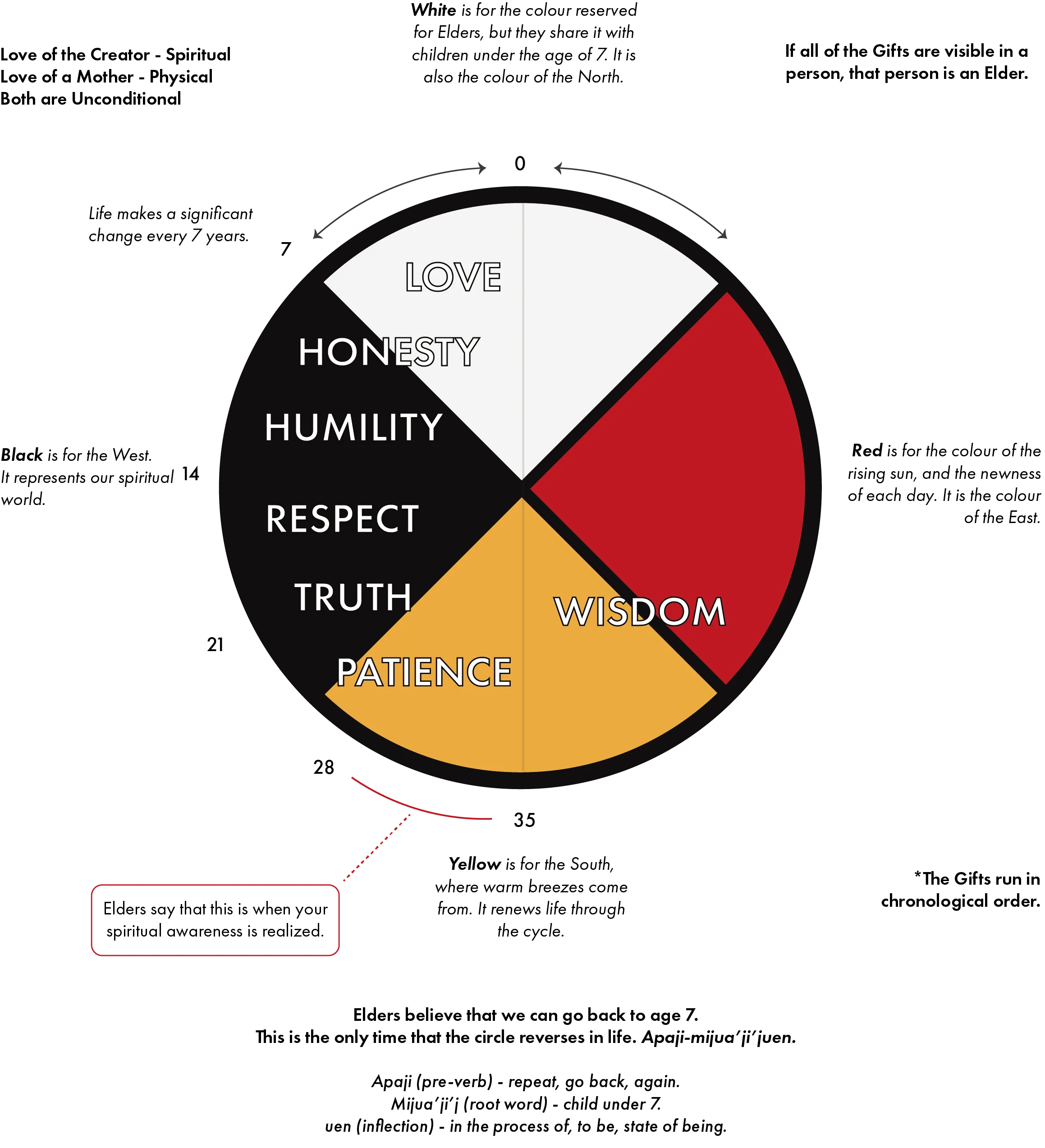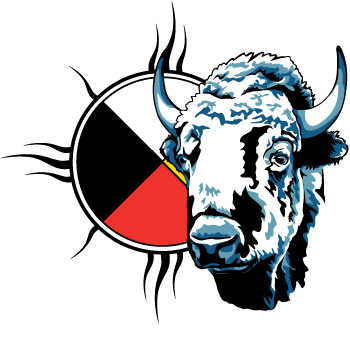Seven Sacred Teachings
The Seven Sacred Teachings or Seven Grandfather Teachings are said to have originated with the Anishinaabe people but have been adopted by many Indigenous people and tribes across Turtle Island as a guide for living in harmony with all our relations. Specifically, the Mi’kmaq people have adopted the seven sacred teachings, and they even appear within their creation story. The Seven Sacred Teachings teach us about how to achieve harmony and happiness in life, and give us very important understandings to teach, practice, and live by. These teachings have been shared over generations as a method to teach future generations how to be a good person, and in modern times, are often utilized in child rearing, social organizations, Indigenous communities, and other important Indigenous connections.
Mi'kmaq Creation Story
“The first person that was created on this Earth was Glooscap, with his head lying in the direction of the rising sun, and his feet in the direction of the setting sun. And his arms were outstretched, one to the south, and one to the north.
And so Glooscap was created on the surface of the Earth, stretched out in the four directions. And he was created with all the Earth’s elements: the dirt and leaves, the plants and stones and wood. Everything was gathered to form Glooscap on the surface of the earth.
But creation did not begin with Glooscap. He came to life within the Seven Levels of Creation, which are represented by the Seven Sacred Directions.
.webp)
The Seven Sacred Directions & the Seven Levels of Creation
These are the Seven Sacred Directions that represent the seven levels of Creation” (Augustine, 2006).
The Giver of Life
The first level of creation comes with The Giver of Life. In the Mi’kmaq understanding of the world, the sky or the direction above is symbolic of this first level of creation.
Grandfather Sun
The second level of creation is our Grandfather Sun. The sun is symbolic of the centre direction and of the self.
Mother Earth
The third level of creation is Mother Earth. She is represented in the direction below us.
Glooscap With His Head To The East
The fourth level of creation is represented by Glooscap lying with his head in the East as he is being formed. And the quality of leadership is associated with this direction, as well as the birds.
Grandmother in the South
The fifth level of creation is represented by Grandmother in the South - she is symbolic of wisdom and knowledge, and the animal life.
The Young Man in the West
The sixth level of creation is represented by the Young Man, the nephew, and the west. He is symbolic of youth and vision and strength, and the fish, the ocean life.
The Mother in the North
The seventh level of creation is represented by the mother in the North - she is symbolic of understanding and love, and the plant life.
Sacred Number 7
There are many references and uses to the number seven in Mi’kmaq culture, some examples are: the seven original districts, seven levels of creation, seven sacred directions, seven original families, seven sacred fires, and the seven sacred teachings.


Mi’kmaw Seven Sacred Gifts of Life
Elder Murdena Marshall of Eskasoni First Nation developed a teaching the “Seven Sacred Gifts of Life”. This teaching offers another interpretation of the Seven Sacred Teachings, by looking at them as a life cycle & utilizing the medicine wheel (see figure below). This teaching tells us that when we are 0-7 or an Elder, we possess the gift of “Love”. Love represents purity and all other teachings need to be present to achieve love in its truest form. During the ages of 7-28 years of age, you start to understand the meaning behind most of the other teachings, and lose love in its purest form, and do not have the gift returned until you reach the status of elder. During this life stage you learn honesty, respect, humility, and truth, however it is not until between 28 years and 35 years that you begin to have the gift of patience and may start to have the gift of wisdom. Once you possess the gift of all teachings including wisdom, you once again contain the gift of love, as you are reaching the end of your life cycle and will soon be returning to the spirit world.

Mi'kmaq Sacred Teachings
Seven Stages of Life with the Seven Gifts

Seven Sacred Teachings – Comprehensive & Versatile
The Seven Sacred Teachings are comprehensive and versatile in that they can be applied to many situations, events, and age demographics. Books have been written on the Seven Sacred Teachings for children, as a healthy way of living and learning, and they have also been utilized when analyzing complex issues such as eliminating the Indian Act (Borrows, 2008). A book written for children intitled “Grandfather Tell Us About the History of the Seven Teachings” by Sandra Samatte (2008), provides a simplistic, yet impactful look on what the Seven Sacred Teachings, and their animal representations have to offer everyone. Furthermore, the “Seven Sacred Teachings of White Buffalo Calf Women” by Bouchard and Martin, help to illustrate the Seven Sacred Teachings effective use in story-telling and highlight the strong connection with nature (2009).
We will be utilizing both sources as we take a closer look at each of the seven teachings.

Love
The first teaching is love, which is represented by the eagle, who flies above the earth, seeing all that is true, and closest to the creator. Bouchard and Martin, also say that love is represented by a deep-violet color (2009). Love must be interpreted utilizing a wholistic view. Love means not only love of one another, but also love of oneself, one’s family, one’s enemies, animals, plants, and all living things. Although Samatte presents love first in her book, Bouchard and Martin make a point to present it last, with the belief that love is at the core of the other teachings, and you can only know love once you know and practice the other teachings. They say, “There is no short cut to achieving the state of love and you cannot know love unless you are courageous. You cannot know love unless you are honest. Love is based on the wisdom to understand oneself and the humility to accept weaknesses as well as being proud of one’s strengths” (2009)

Humility
Humility is represented by the East, the spring, and yellow, believed to be reference to the rising sun (Bouchard & Martin, 2009). Humility is also represented by the wolf. “Look to Wolf – Ma’iingan – for humility. Observe how Ma’iingan does not live for himself but for the pack. Watch him bow his head in the presence of others. He does this out of deference, not fright. Ma’iingan understands what a small part of the whole he plays. His ultimate punishment is to be cast away from his community. Learn this kind of humility. Learn to not be arrogant. Do not think too highly of yourself. Do not want for yourself. Become Ma’iingan. Become humble” (Bouchard & Martin, 2009). With true humility, we often place the needs of others or the greater good before our own, and therefore this the message contained within this teaching, is also not to be selfish, self-serving, or arrogant.

Honesty
Honestly is represented by south, and summer, and the middle of your journey (Bouchard & Martin, 2009). Honestly is also represented by Kitchi- Sabe. “Kitchi-Sabe is the four-legged who walks on two legs. Sabe reminds us to be ourselves and not someone we are not. An honest person is said to walk tall like Kitchi-Sabe” (Bouchard & Martin, 2009). “To be honest with yourself allows you to be honest with everyone around you (Samatte, 2008). Honesty, like the other teachings is rooted in complexity because it has so many different means and interpretations. Being honest with oneself, being honest with others, being honest about perspective, about short comings, about your spiritual place, about history, and about change & reconciliation are all concepts that can arise when looking at the teaching of honesty.

Respect
Respect is represented by the west, the fall, sunset, and the buffalo (Bouchard & Martin, 2009). Respect can also be interpreted, and should be interpreted in many ways, all at once. Respect for the earth, for resources, for others, and respect for oneself are all key concepts in this teaching. Bouchard and Martin say, “Do not waste. Use all things wisely. Never take more than you need and always give away that which you do not use. And treat others as you would have them treat you, respectfully. Learn respect and learn balance. What goes up will come down. What you do for others will be done for you. What you give away will always come back to you in the One Circle” (2009).

Courage
Courage is represented by the direction north and season winter. Courage is also represented by the bear and later in the life cycle. “You are older now. Your hair is white. You are in the winter of your life. You have learned much. You understand to always act on what is right for you and for your family. To do what is right is not easy. It takes courage. It takes courage to heal that which is not well within you before being reborn. Become healer. Become Makwa. Just as courage sleeps in Makwa through long winter months, it is dormant within you. It need only be awakened. Observe Makwa fight when her young are threatened. She will not stop until she overcomes all threats. In your life, you will need courage to transform fears that might prevent you from living a good life. Makwa shows you how to face fear and danger” (Bouchard & Martin, 2009).

Wisdom
Wisdom is represented by blue, Grandfather Sky, and the beaver, according to Bouchard & Martin (2009). Wisdom is something often associated with Elders and Elder knowledge and must be lived and learned. We gain wisdom by listening and watching and gaining a better understanding of the world and the spirit world. Wisdom, unlike the other teachings is not as universal in understanding. It is something that differs from knowledge and is gained, however, some can be born with natural abilities that provide them with better opportunities to gain wisdom, such as being a good listener & deep thinker. In simpler terms Samatte refers to wisdom as the understanding of what is right and what is wrong (2008). Bouchard & Martin describe their understanding of this teaching by saying, “Notice what is going on around you. Observe your life and the lives of others. By watching and listening you can learn everything you need to know. Knowledge can be learned. Wisdom must be lived. Live and learn. Look into any clear lake. You do not see your reflection. You see that of those who came before you. Through All Your Relations and this Teaching of Wisdom, you will come to use your gift to direct your life’s journey. Do not live based on what you wish you were. Live on what you are” (2009).

Truth
Truth is represented by green, mother earth, and the turtle according to Bouchard & Martin (2009). Truth is also a complex teaching, as it can refer to speaking the truth, telling the truth, living your truth, praying for truth, understanding the truth, and other important principles. It is said that living with truth and acknowledging truth you will live a happier, simpler life without discourse. Bouchard & Martin say, “Look to Miskwaadesii (turtle) for one whose existence is strong and stable. Slow-moving Miskwaadesii understands, as you should, that the journey of life is as important as the destination” (2009).
Conclusion
Ultimately the Seven Sacred Teachings or Grandfather Teachings are principles to live by. They are simple, yet complex understandings to offer a life guided by our ancestors and their past-on knowledge contained within these teachings. They can be applied to our physical self, our mental self, our spiritual self, and our emotional self. They are transverse and can be applied by the individual according to the situation they are facing, but also on broader national or global scale. The reality is, if we all lived by these principles the world would be a much better place. These principles are connected in all levels of nature, also in keeping with Mi’kmaq traditional, and it only takes the perception of the individual to see them as such. To summarize the Seven Sacred Teachings into one document or one understanding is tedious as they are interpreted by each individual person yet apply to all circumstances. We focused on a few individuals’ understanding of the sacred teachings, which then were passed on for others interpretation, there is no right or wrong interpretation, there is only these teachings and concepts, which we apply to our lives in the best way that resonates with us as individuals, communities, and governments.
Note: Much of Mi'kmaw history has been passed down through oral tradition. The stories and histories shared here are based largely on those oral accounts, which may vary slightly between communities, Elders, and storytellers. These variations are a natural and valued part of the oral tradition. If you have any questions about these histories, or would like to contribute with information passed down to you, please contact us at cdadmin@unsm.org.
Samatte, Sandra, Grandfather Tell Us About the History of the Seven Teachings, 2008
Bouchard, David & Martin, Joseph, The Seven Sacred Teachings of White Buffalo Calf Woman, 2009
Augustine, Stephen, FourDirectionsTeachings.com, 2006
Marshall, Murdena & Johnson, Tom, Mikmaw Seven Sacred Gifts of Life
